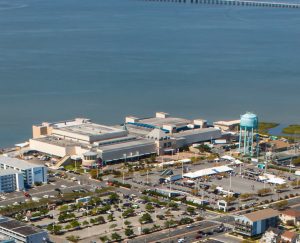
OCEAN CITY – Officials in Ocean City this week approved on second reading a $28 million bond sale that will finance several large projects, but not before hearing opposition from the public.
On Monday, the Mayor and Council unanimously agreed to a second reading of an ordinance that will allow for the sale of $28 million in general obligation bonds. Money will be used to finance a $34 million expansion to the Roland E. Powell Convention Center, $29 million in upgrades to the town’s Public Works campus from 65th to 67th streets bayside and a new $3 million Public Works South Facility at 2nd Street.
While state funds or federal grants will pay a considerable portion of the expansion and upgrade projects, the town will still be responsible for funding their $28-million share. For example, Ocean City will be responsible for paying $14 million for the expansion at the Roland E. Powell Convention Center, $11 million for the Public Works and Transit Facility upgrades and $3 million of the new Public Works South Facility.
In the meeting, resident Vince Gisriel, a former town councilman, argued, among other things, that the demand for convention center space, or the lack thereof, did not warrant another expansion to the convention center, which will add 30,000 square feet of exhibit space on the north side of the facility.
He said a prior feasibility study from 1990 showed little need for large exhibit spaces and an updated study from 1994 indicated an 8.8 percent drop in convention attendance from 1981-1991.
“As I read the latest feasibility study by Crossroads I saw similar patterns emerging,” he said.
From statistics in the most recent Crossroads study, Gisriel pointed out that existing space at the convention center could accommodate many conventions.
“The latest survey indicates the existing potential users required an average of 46,300 square feet, which we can currently accommodate,” he said. “It also pointed out 41 percent of Maryland conventions and exhibit space require up to 60,000 square feet, which we can accommodate today. On 11 percent of conventions and exhibits require up to 90,000, which this project is planning to do.”
In addition to the convention center, Gisriel directed the council’s focus to other capital projects in the planning pipeline, including the construction of a new 2nd Street Public Works facility and upgrades to the Public Works campus.
He said his comments at prior meetings earlier this year regarding the costs and feasibility of such projects have garnered little discussion from the council in subsequent meetings.
“It’s almost like these projects are done deals,” he said.
He argued that non-essential projects should be brought to a referendum.
“I think it is time that this council and this town consider voting on non-essential items like the subject of this ordinance,” he said. “Let the voters decide whether they want to be indebted to this kind of money.”
Resident Tony Christ agreed with Gisriel.
“I think this is the largest bond of new money, new debt, that I’ve ever seen,” he said.
Christ argued that the council needed a stronger justification for spending millions on certain projects.
“What is excessive and what isn’t?” he said. “What would you do with your own money, people?”
Members of the council, however, were in agreement that projects like the convention center expansion, campus upgrades and new Public Works facility were necessary for the town to thrive.
Councilman Dennis Dare argued that the projects would address issues that will improve the town’s facilities. For example, he said money used on upgrades to the town’s Public Works campus would better accommodate vehicles, while a new facility at 2nd Street would replace the town’s existing public works yard at South 1st Street and would better serve as a staging and maintenance area of the Boardwalk trams.
“We are trying to take care of the infrastructure that will allow the town to prosper,” he said.
Councilman John Gehrig added that investing in infrastructure now would benefit the town in the future.
“There is a saying that the time to fix a leaking roof isn’t during a storm …,” he said. “You are concerned now that we are spending money, but how much concern and blame will there be when the roof is leaking and we weren’t prepared and should have seen it coming?”
Gehrig argued that maintaining the resort’s infrastructure is imperative to the town’s success.
“If we don’t invest, we don’t have customers,” he said. “If we don’t have customers, your property taxes are going up for sure. That’s a promise … We must take care of our customers, and our customers include us.”
Mayor Rick Meehan agreed.
“I believe the council is moving in the right direction,” he said. “We invest in our community and we see other people are willing to invest in our community …”
Following a lengthy discussion, the council voted 6-0, with Council President Lloyd Martin absent, to approve the ordinance.

